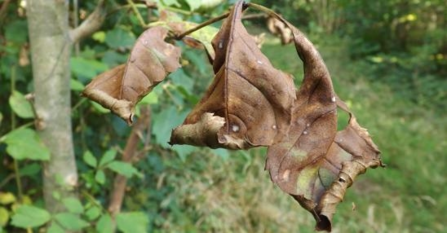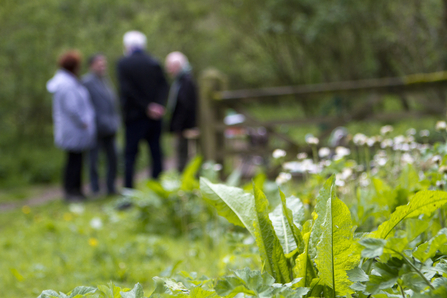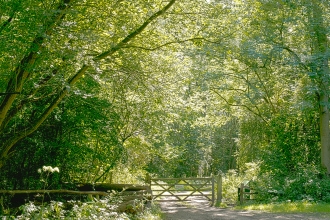A fatal fungal disease of ash trees
First confirmed in the UK in 2012, ash dieback, also known as 'Chalara' or 'Chalara ash dieback', is a disease of ash trees caused by a fungus called Hymenoscyphus fraxineus.
This disease has spread quickly and is now affecting woodlands across the UK, leading to the death of thousands of trees. It has already caused widespread damage in continental Europe.
Latest Updates
19th February 2024
The Trust's Head of Communications, Erin McDaid, took part in an interview on Notts Today talking about the threat of Ash Dieback and the challenges faced by the Trust in tackling it. Visit the Notts TV page for the episode and skip to 26:24 to see the interview.

Infected ash leaf - Photo © Steve Collin
What is ash dieback?
Ash dieback is a disease that affects ash trees, caused by a fungus called Hymenoscyphus fraxineus. The fungus has two stages to its lifecycle - a sexual stage, which helps the fungus spread, and an asexual stage, which is what grows on the tree and causes damage. The fungus blocks water transport in the tree, leading to lesions in the bark, leaf loss and the dieback of the crown.
Ash dieback fungus is believed to have originated in Asia. It was first discovered in Europe in Poland in 1992, and is now found widely across the continent. The first confirmed case in the UK came in 2012, since when it has spread across England and to Scotland, Wales, Northern Ireland, and the Isle of Man.
It is anticipated that up to 80% of ash trees across the UK could be lost to the disease. It has also been estimated that the total cost to the UK economy could be as much as £15 billion, with over £7 billion cost by 2030.
Ash dieback symptoms
The main symptoms of ash dieback are:
-
Dead branches
-
Blackening of leaves which often hang on the tree
-
Discoloured stems often with a diamond-shape lesion where a leaf was attached
Trees may eventually drop limbs, collapse or fall. The symptoms are often easier to spot in mid-late summer when a healthy ash should be in full leaf. It becomes much harder in autumn when leaves are naturally changing colour and falling.
Once a tree is infected the disease is usually fatal, either directly, or indirectly by weakening the tree to the point where it succumbs more readily to attacks by other pests or pathogens, such as honey fungus. These secondary pathogens can cause butt or root rot, leading to the tree falling.
How does it spread?
The disease may spread locally (over tens of miles) by wind dispersal. The reproductive stage of the fungus grows on the previous year's fallen leaves, producing fruiting bodies that release spores between June and September. These spores are dispersed by the wind and settle on the leaves of healthy trees. If a healthy tree receives a high enough dose of spores, it too will become infected. Over longer distances, the disease may be spread by the movement of infected ash plants.
Management
There is no cure for ash dieback, but some trees are less susceptible to the disease. Investigating this natural resistance could be the best way to secure the future of the UK's ash trees. Ash dieback causes trees to slowly die, drop limbs, collapse or fall. In places where infected trees grow beside roads and footpaths, they are likely to pose a threat to public safety. As a result, in some cases infected ash trees are removed for the safety of site users and to help control the spread of the disease. In these cases, ecological surveys are important to check for the presence of protected species such as badgers and dormice, enabling the appropriate mitigation to be undertaken.

Managing our woodlands for nature and people
The impact of Ash dieback on Nottinghamshire Wildlife Trust sites
Our tree safety surveys show that Ash trees on many of our nature reserves are affected by Ash dieback disease. There is no cure, and the disease causes trees to slowly die. This can lead to them collapsing or falling – posing a risk to the safety of visitors.
What are we doing about ash dieback on our nature reserves?
Even though we’re still learning about the impacts of ash dieback, and the challenge is significant, we are fighting back. We keep a close eye on the health of trees in all our woods.
Health and Safety considerations are central to our woodland management decisions, alongside maximising opportunities to turn the challenge of ash dieback into an opportunity to benefit wildlife.
We protect and seek to enhance habitats and species
As well as tackling dangerous trees where necessary, we are also looking for opportunities to benefit the wildlife on our nature reserves
It is very important that the resilience of our woods is improved over time so they can resist and recover from pest and disease outbreaks. We are working to make the most of opportunities to enhance the ecological functioning of the wood, including retaining deadwood, replanting with native species and encouraging natural regeneration.
We seek to retain ash trees, where it’s safe to do so
We look for ways to retain trees which is increasingly possible in less visited areas of our woods, away from footpaths, or in larger sites where paths can be diverted to give nature time and space to respond rather than intervening. Please look out for signs indicating path closures and follow alternative routes.
Allowing nature this space can provide the opportunity for any retained, and potentially tolerant ash, to naturally regenerate or for affected ash tree to provide deadwood habitats for wildlife.
Nottinghamshire Wildlife Trust’s nature reserves provide a unique free resource for the public to see, enjoy and get close to nature but balancing the needs of wildlife and people with limited resources can be challenging - but with your support we can tackle ash dieback whilst ensuring our woodland areas remain havens for people and nature.
Help us fight ash dieback in Nottinghamshire!










